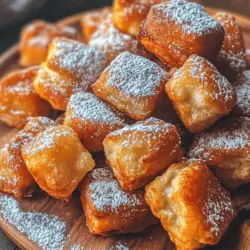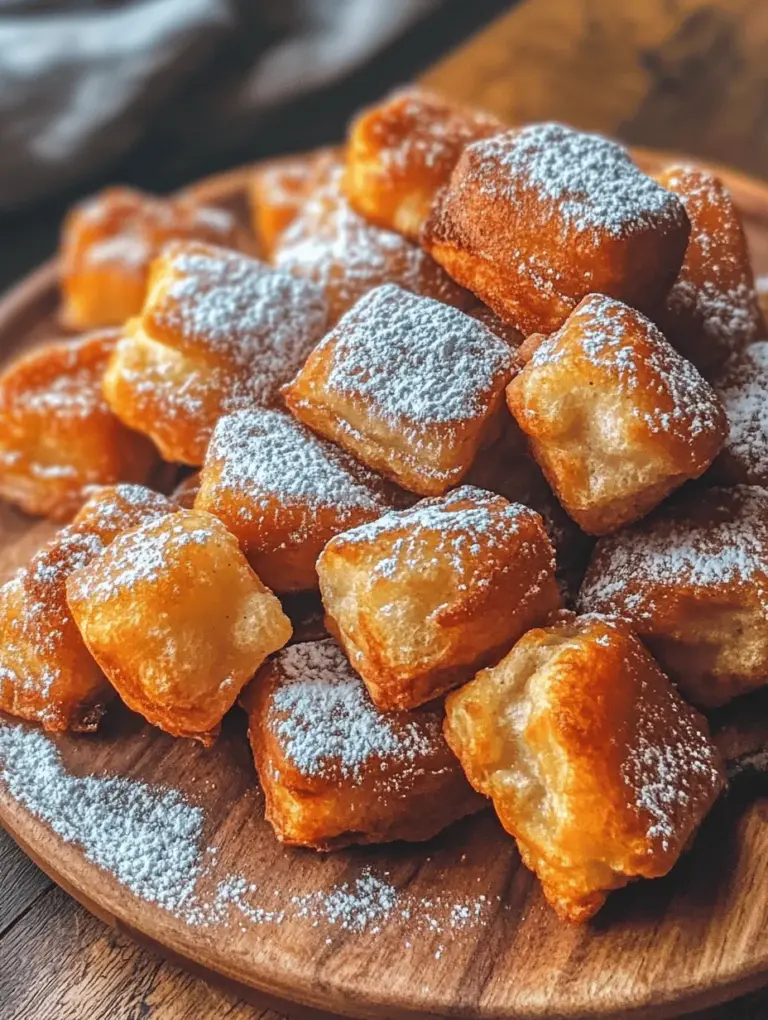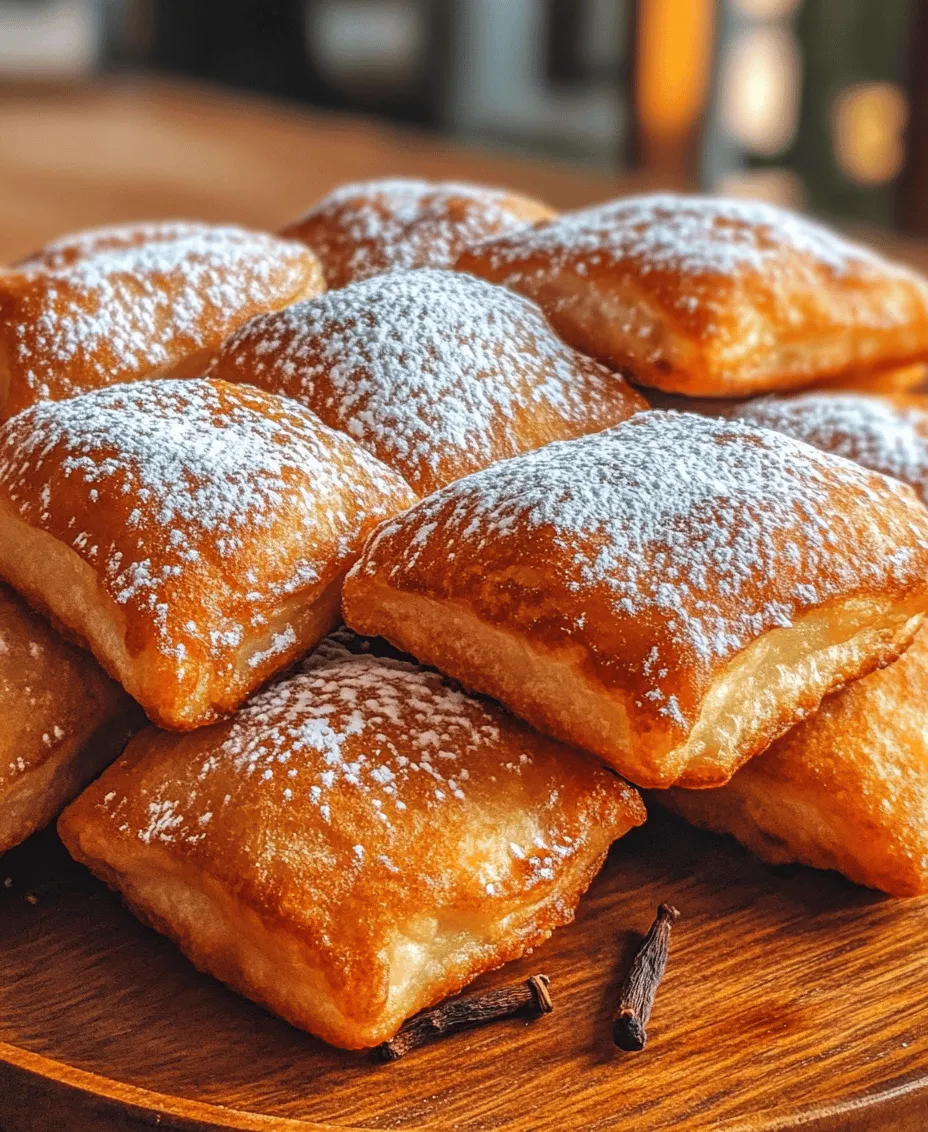Introduction
If you’ve ever strolled through the vibrant streets of New Orleans or savored the delights of a traditional French café, you’ve likely encountered the irresistible charm of beignets. These pillowy, fried pastries are not just a treat; they are steeped in rich cultural significance, embodying the joyful spirit of gatherings and celebrations. Originating from France and evolving into a beloved delicacy in various regions, particularly Louisiana, beignets have become synonymous with indulgence and comfort.
In this article, we will explore a delightful vanilla French beignet recipe that captures the essence of this classic treat. With its light, airy texture and a hint of vanilla sweetness, these beignets promise an enchanting flavor experience that will transport your taste buds straight to the heart of French culinary tradition. What makes this recipe particularly appealing is its simplicity, making it accessible to both novice bakers and seasoned professionals. Whether you’re preparing for a special occasion or simply wishing to enjoy a warm, fresh pastry, this beignet recipe is sure to impress.
The Origins of Beignets
The history of beignets dates back centuries, with roots in Europe, specifically in France. The term “beignet” is derived from the French word “beignets,” which means “to dip.” Initially, these treats were made as simple fried dough, often enjoyed by the working class as a convenient snack. Over time, the recipe evolved, taking on various forms and flavors, with the classic square shape becoming a staple.
When French settlers arrived in Louisiana, they brought their culinary traditions with them, including the beloved beignet. In the vibrant Creole culture of New Orleans, beignets flourished and adapted, becoming a signature dish. Today, they are famously served at Café du Monde, where locals and tourists alike indulge in powdered sugar-dusted beignets alongside a café au lait. This cultural significance is underscored during celebrations such as Mardi Gras, where beignets are enjoyed as a festive treat.
The evolution of the beignet reflects not only the adaptability of the recipe but also the blending of cultural influences that characterize New Orleans cuisine. From a humble pastry to a symbol of celebration, beignets have carved out a cherished place in culinary history, embodying the joy of sharing delicious food with loved ones.
Understanding the Ingredients
Creating the perfect beignet starts with understanding the ingredients that contribute to its delightful flavor and texture. Below is a breakdown of each key component involved in our vanilla French beignet recipe:
All-Purpose Flour
All-purpose flour is the foundation of the beignet dough. It provides the necessary structure and stability, allowing the dough to rise beautifully during frying. The right flour ensures that the beignets are light and fluffy, with a tender crumb that melts in your mouth.
Granulated Sugar
Granulated sugar plays a dual role in the beignet recipe. Not only does it sweeten the dough, enhancing the overall flavor profile, but it also contributes to the browning process during frying. This results in a beautifully golden exterior that contrasts with the soft interior, creating a delightful textural experience.
Instant Yeast
The heart of any good beignet lies in its leavening agent. Instant yeast is essential for achieving the perfect rise, creating that characteristic lightness that makes beignets so irresistible. Unlike active dry yeast, instant yeast does not require proofing, allowing for a quicker and more straightforward preparation process.
Salt and Ground Cinnamon
While salt is often overlooked, it is a crucial ingredient that balances the sweetness of the beignets. A pinch of salt enhances the overall flavor, preventing the dough from tasting flat. Ground cinnamon adds a warm, comforting note that complements the vanilla, making each bite extra special.
Whole Milk
Warm whole milk is another vital component of the dough. It not only helps to activate the yeast but also enriches the beignet mixture, contributing to a soft, tender texture. The warmth of the milk encourages fermentation, ensuring that the dough rises properly.
Egg
Eggs are essential for providing structure and moisture to the beignets. They contribute to the richness of the dough while also aiding in the binding process, ensuring that the beignets hold their shape during frying.
Unsalted Butter and Vanilla Extract
Unsalted butter adds a luscious richness to the dough, elevating the flavor profile and creating a tender crumb. Paired with pure vanilla extract, which infuses the beignets with aromatic sweetness, these ingredients create a truly delightful pastry experience. For an even more pronounced vanilla flavor, consider using vanilla bean, which adds both taste and visual appeal to the finished product.
Vegetable Oil
Choosing the right oil for frying is critical to achieving the perfect beignet. Vegetable oil has a high smoke point, making it ideal for deep frying. This ensures that the beignets cook evenly and develop a crisp, golden-brown exterior while remaining soft and fluffy inside.
Powdered Sugar
The final touch to our delightful vanilla French beignets is a generous dusting of powdered sugar. This not only adds sweetness but also enhances the visual appeal, creating that iconic look that makes beignets so enticing.
Optional Vanilla Bean
For those looking to elevate their beignets to a gourmet level, incorporating vanilla bean into the dough is an excellent option. The tiny specks of vanilla seeds not only enhance the flavor but also add a beautiful aesthetic, making your beignets look as delightful as they taste.
With a solid understanding of the ingredients, you’re now equipped to embark on the journey of making your own delightful vanilla French beignets. Let’s dive into the preparation process and discover how to turn these simple components into a delicious masterpiece.
Next Steps: Preparing the Dough
To begin making your beignets, gather all the ingredients listed above. Start by measuring out your all-purpose flour, sugar, instant yeast, salt, and ground cinnamon into a large mixing bowl. In a separate bowl, whisk together the warm milk, egg, melted unsalted butter, and vanilla extract until combined. Gradually incorporate the wet ingredients into the dry mixture, stirring until a soft dough forms.
Knead the dough on a lightly floured surface for about 5-7 minutes, until it becomes smooth and elastic. This step is crucial, as it develops the gluten structure needed for the beignets to rise properly. Once kneaded, place the dough in a lightly greased bowl, cover it with a clean kitchen towel, and allow it to rise in a warm, draft-free area for about 1-2 hours or until it has doubled in size.
As the dough rises, the anticipation builds, and you’ll soon be ready to transform this simple mixture into an extraordinary treat. Stay tuned for the next steps, where we’ll shape and fry these delightful vanilla French beignets to perfection, ensuring that they are as delicious as they sound.
Step-by-Step Guide to Making Vanilla French Beignets
Creating delightful vanilla French beignets at home is an exciting culinary adventure. Let’s delve into the essential steps that will guide you through the process, ensuring that your beignets are fluffy, light, and utterly delicious.
Preparation: Essential Tools and Equipment Needed for the Recipe
Before you begin, gather the following tools and equipment to streamline your baking process:
– Mixing Bowls: A large bowl for combining ingredients and a smaller bowl for yeast activation.
– Measuring Cups and Spoons: For precise measurements of dry and wet ingredients.
– Whisk: To mix dry ingredients and activate the yeast.
– Dough Scraper: Helpful for handling sticky dough.
– Rolling Pin: For flattening the dough to the desired thickness.
– Cutting Board: A clean surface for shaping the beignets.
– Frying Thermometer: To monitor oil temperature for frying.
– Deep Fryer or Heavy Pot: For frying the beignets.
– Slotted Spoon: To remove the fried beignets from the oil.
– Cooling Rack: For draining excess oil from the beignets after frying.
Having all these tools on hand will make the baking process more enjoyable and efficient.
Making the Dough: Detailed Instructions for Mixing Dry and Wet Ingredients
1. Activate the Yeast: In a small bowl, combine 2 teaspoons of active dry yeast with 1/4 cup of warm water (about 110°F). Let it sit for about 5-10 minutes until it becomes frothy. This indicates that the yeast is active.
2. Mix Dry Ingredients: In a large mixing bowl, whisk together 2 cups of all-purpose flour, 1/4 cup of granulated sugar, 1 teaspoon of salt, and 1/2 teaspoon of baking powder. These ingredients will form the base of your beignet dough.
3. Combine Wet Ingredients: In another bowl, whisk together the activated yeast mixture, 1/2 cup of whole milk, 1 large egg, and 2 tablespoons of melted unsalted butter. Add in 2 teaspoons of pure vanilla extract for that delightful flavor.
4. Mix Together: Pour the wet mixture into the dry ingredients. Using a sturdy spatula or wooden spoon, stir until the dough begins to come together. It will be somewhat sticky, which is normal.
Kneading Techniques: Importance of Proper Kneading for Dough Elasticity
Kneading is crucial for developing gluten, which gives the beignets their chewy texture.
1. Transfer the Dough: Lightly flour your work surface and place the dough onto it. Dust a small amount of flour over the top to prevent sticking.
2. Knead the Dough: Using the heel of your hand, push the dough away from you, fold it over itself, and give it a quarter turn. Repeat this process for about 8-10 minutes until the dough is smooth and elastic. If the dough is too sticky, add a little flour as needed, but be careful not to overdo it, as too much flour can make the beignets dense.
Proofing the Dough: Explanation of the Proofing Process and Tips for Optimal Results
Proofing allows the dough to rise and develop flavor.
1. First Proofing: Place the kneaded dough in a lightly oiled bowl, cover it with a clean kitchen towel or plastic wrap, and let it rise in a warm place for about 1-2 hours or until it doubles in size.
2. Tips for Optimal Results: For a warm environment, you can turn your oven on to the lowest setting for a few minutes, then turn it off and place the dough inside. Alternatively, a sunny spot in your kitchen works well.
Shaping the Beignets: Techniques for Cutting and Shaping the Dough into Squares
Once the dough has risen, it’s time to shape your beignets.
1. Roll Out the Dough: On a lightly floured surface, roll out the dough to about 1/4-inch thickness. Use a rolling pin to ensure an even thickness.
2. Cut the Beignets: Use a sharp knife or a pizza cutter to cut the dough into squares or rectangles, approximately 2-3 inches in size. The size can vary according to your preference.
Second Proofing: Importance of the Second Rise for Light and Fluffy Texture
The second proofing ensures that your beignets are light and fluffy.
1. Prepare for Second Proofing: Place the cut-out beignet pieces on a floured baking sheet, ensuring they have enough space to expand. Cover them lightly with plastic wrap or a towel.
2. Let Them Rise: Allow the beignets to rise for another 30-45 minutes until they puff up noticeably.
Frying Process: Guidelines for Achieving the Perfect Frying Temperature and Technique
Frying is the final step to achieving that golden, crispy exterior.
1. Heat the Oil: In a deep fryer or heavy pot, pour in vegetable oil to a depth of about 2-3 inches and heat it over medium heat. Use a frying thermometer to monitor the temperature, aiming for around 350°F (175°C).
2. Fry the Beignets: Carefully drop a few beignet pieces into the hot oil, being cautious not to overcrowd the pot. Fry for about 1-2 minutes on each side or until they are golden brown. Use a slotted spoon to turn them as needed.
3. Drain Excess Oil: Once fried, transfer the beignets to a cooling rack lined with paper towels to absorb any excess oil. This step helps maintain their crisp texture.
Dusting with Sugar: Best Practices for Dusting Beignets with Powdered Sugar
Finishing your beignets with a dusting of powdered sugar adds just the right touch.
1. Dust the Beignets: While the beignets are still warm, generously dust them with powdered sugar. Use a fine mesh sieve for an even distribution, ensuring they are coated on all sides.
2. Serving Suggestion: For an extra touch, consider tossing them in flavored sugar or cinnamon sugar for a variation on the classic.
Serving Suggestions
Vanilla French beignets are a versatile treat that pairs beautifully with various accompaniments and presentation ideas.
Ideal Accompaniments for Beignets
– Coffee: A classic pairing, especially with chicory coffee or a rich espresso, enhances the sweet flavors of the beignets.
– Chocolate Sauce: Drizzling warm chocolate sauce over the beignets creates a decadent treat that chocolate lovers will appreciate.
– Fruit Preserves: Serve with a side of raspberry or strawberry preserves for a fruity twist that complements the vanilla flavor.
Presentation Ideas for Serving Beignets at Gatherings or Special Occasions
– Platter Display: Arrange the beignets on a decorative platter, garnished with fresh berries or mint leaves for an elegant touch.
– Individual Servings: Place a few beignets in small paper bags or boxes tied with twine for a charming, rustic presentation at parties or events.
Variations and Flavor Options for Customization
– Flavored Sugars: Experiment with different flavored sugars, such as lemon or orange zest mixed with powdered sugar, for added zest.
– Fillings: Consider filling the beignets with pastry cream, fruit preserves, or chocolate ganache before frying for delightful surprises.
Nutritional Information
Understanding the nutritional content of your beignets can help you enjoy them in moderation.
– Overview of Nutritional Content: Each serving of a vanilla French beignet (about 1 beignet) contains approximately 150-200 calories, depending on size and amount of sugar used. They are relatively high in carbohydrates and sugars due to the flour and sugar content.
– Portion Sizes and Indulgence: While beignets are a delightful treat, it is wise to enjoy them in moderation. Consider serving them in smaller portions or sharing with friends and family to make the indulgence more special.
Conclusion
Vanilla French beignets are a delightful and versatile pastry that can elevate any breakfast, brunch, or dessert table. The combination of light, airy dough with the sweet dusting of powdered sugar creates an irresistible treat that’s perfect for sharing with loved ones or enjoying as a special indulgence.
We encourage you to try this recipe at home and experience the joy of crafting these delicious pastries from scratch. The process of making beignets is not only rewarding but also allows you to share a piece of French culinary tradition with those you care about. Enjoy the satisfaction of baking and the pleasure of sharing homemade treats that are sure to bring smiles all around.



